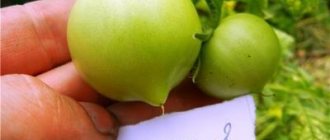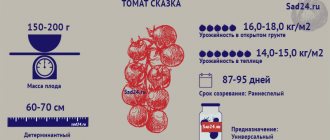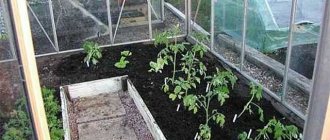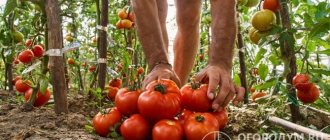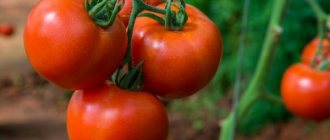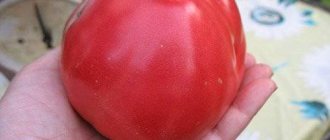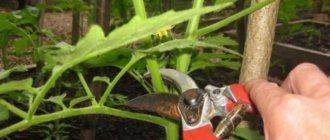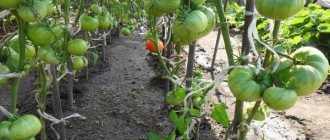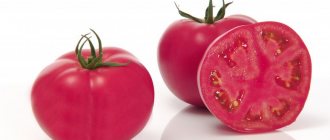Author's rating
Author of the article
Yakov Pavlovich
Professor, Head of the Department of Vegetable Growing
Articles written
153
Sweet juicy tomatoes attract the attention of those who like to diversify their menu with tasty and healthy food. Among the varieties of this crop, you should pay attention to the Pink Paradise tomato, which came to Russia from Japan. This is an indeterminate hybrid that produces a high yield of large pink fruits. Easy care and excellent characteristics have made it popular among vegetable growers.
Description and characteristics of Pink Paradise tomato
A detailed description of the tomato includes the following characteristics:
- indeterminate mid-season hybrid F1;
- original origin: Japan;
- fruit shape is round;
- pink colour;
- ripens in 100 days;
- fruit weight - 150-200 g;
- table variety;
- yield - 2 kg/s bush.
The bush is 2.5 m high, heat-loving, grown under cover or in greenhouses. The fruits weigh up to 200 g. Sweet, pleasant taste, juicy, fleshy core. The skin is dense and does not crack. After ripening, the color is pink without a green border at the stalk. Mid-season tomato varieties ripen 75 days after the seedlings are moved to the ridges.
You should know that the F1 sign in the name of the Pink Paradise tomato means that it belongs to hybrids, the seeds of which do not retain the properties of the given plant and are unsuitable for propagation.
Transferring plants to a greenhouse
For tall varieties such as Pink Paradise, staggered planting is usually used. This diagram shows planting for 32 bushes, but it can be adjusted depending on the required number of plants.
Landing instructions:
- Planting begins in May. By this time the beds should be ready. The height of the beds should not exceed 40 cm, and the approximate width should be 60-65 cm. The passage should be no more than half a meter wide.
- Holes are made in the beds. In this case, the distance between the rows should be from 80 cm to a meter, and the distance from one hole to another should be 70 cm.
- Immediately before planting, the soil must be treated with a solution of potassium permanganate and copper sulfate.
- The plants themselves, before being planted in the greenhouse, are watered with phytosporin.
- When tomatoes are planted in a hole, each bush must be tied to a long stake strong enough to support the plant.
- After this, each bush needs to be watered.
Pros and cons of a hybrid
The Pink Paradise hybrid has gained popularity among vegetable growers. It has a number of advantages due to which gardeners choose it for growing.
Main advantages:
- High yield.
- Early maturation.
- Great taste.
- Easy to care for.
- Immunity to cold.
- Persistent immunity to diseases.
The disadvantages of Pink Paradise include the abundant growth of stepsons and leaves, the need to remove them and form a bush.
Growing highlights
For this purpose, a nutritious and light soil mixture is prepared, preferably a mixture of garden and turf soil with the addition of humus. Seeds are not disinfected, but treating them with a growth stimulant will not hurt. Why the material is soaked in liquid for 10-12 hours. Seeds embedded in the soil 1.5 cm are insulated with film on top.
The optimal temperature for seed germination is +25 degrees. The germinated seedlings are moved to a windowsill with bright lighting. Water in moderation as the soil dries out using a spray bottle. When the first true leaves appear, the seedlings are planted in individual peat-humus pots. After transplantation, the plant is fed with a solution of complex fertilizers.
Tomato seedlings are planted in a greenhouse or in the ground under cover in the last ten days of May, when the soil warms up to +12 degrees. The planting pattern is 40x60 cm. At least 60 cm is left between the bushes. After replanting, the stem of the young seedlings is tied to a wooden support. Watering and fertilizing are carried out 7-10 days after planting.
For the first time, the Pink Paradise tomato is fed with nitrogen, which promotes enhanced growth. Phosphorus-potassium fertilizers are used to set and form fruits. Foliar feeding is also carried out using boric acid. When flowering in the morning, shake the stems a little. So, in self-pollinating tomatoes, fruit set is much more efficient.
Careful pinching is most often done in one stem. The lower leaves along with the shoots are cut off. Overgrown shoots are cut off regularly, which is monitored very carefully. Formation for a bush is mandatory, because you need fruits, not an increase in green mass. After pruning, the bushes are pruned, especially after intensive pruning. Do not water immediately on the same day to avoid infection of the injured areas of the plant with viral, fungal and bacterial pathogens. Water in moderation, but on a regular basis. It is better to pour water into the grooves that are torn around the stem. This way the soil is better saturated with moisture, and the roots of the plant receive the necessary drink.
Subtleties of growing crops
Early ripening Pink Paradise tomatoes are propagated by growing seedlings. It takes at least 100 days for them to ripen. Sow the seeds no later than mid-March, so that young plants can be planted in the greenhouse in May.
We grow seedlings
To obtain high-quality Pink Paradise tomato seedlings, you must follow the following rules:
- prepare special soil;
- choose healthy mature seeds;
- create favorable conditions for plant development.
Pink Paradise tomato seedlings are grown in a warm room; before transplanting into the ground, they are hardened off by moving them to a cool place.
Soil requirements
The composition of the soil is very important for the proper development of the plant. The soil should be nutritious and loose. It contains peat, turf soil, and baking powder. This is usually sand; when preparing a planting mixture at home, vermiculite is added instead of sand.
See also: Planting and caring for tomatoes in a polycarbonate greenhouse
Soil can be bought at the store. Garden centers offer a large selection of mixtures that are enriched with humus or sapropel. The nutritional value of such soils is high; it is important that they do not contain larvae of harmful insects and disease spores.
Expert opinion
Stanislav Pavlovich
Gardener with 17 years of experience and our expert
Ask a Question
Important. Any composition must be disinfected before sowing seeds. To do this, it is spilled with special preparations or exposed to temperatures above 100 degrees.
When to plant
It depends on the region where the crop grows. The mid-season hybrid Pink Paradise is grown in a greenhouse, which means that for the middle zone the time for planting seedlings in the ground will be mid-May. Subtracting from the planting date the age of the seedlings when they can be replanted (50-55 days), we get the time for sowing the seeds - mid-March, you can shift the date until the end of the month.
Planting and caring for seedlings
To grow seedlings, use shallow bowls with nutrient soil, diapers or snails, and peat tablets. Most often they are planted in containers 7-8 cm deep, which should have holes to drain excess liquid from irrigation.
The soil is spilled with hot water or Fitosporin solution for disinfection. The finished seeds have already been processed; they do not need to be soaked; they can be spread dry on moist soil. Sprinkle a 1.5-2 cm layer of soil on top and compact slightly. They make a mini-greenhouse by covering the bowls with film. Tomatoes need a temperature of 25 degrees to germinate.
It takes 5-7 days for the seeds to germinate. Next, they are moved to a bright place, the temperature is reduced to 15 degrees. The film is removed gradually, allowing fresh air into the sprouts. After 2 true leaves appear, the seedlings are planted in separate pots.
Subsequently, the plants are carefully watered as the surface layer of the soil dries. They feed with Agricola and Kemira fertilizers for tomatoes or prepare a nutrient solution themselves. When the tomato seedlings form 5 true leaves and the time is right, they are transplanted into a greenhouse.
Transfer to open ground
It is not recommended to grow the Pink Paradise tomato in open ground. This is a heat-loving, tall (up to 2.5 m) plant. Requires a high shelter, which is difficult to build.
Transplanting plants into a greenhouse
The transplant is carried out between May 9-15, depending on the ambient temperature. Bushes are planted at a distance of 60 cm from each other. Such placement will provide sufficient nutrition; growing bushes will not shade neighboring plants.
What should the structure for tomatoes be like?
Size
The most suitable height of the greenhouse along the ridge is about two and a half meters, since the bushes will reach 2 m, and for normal maintenance it is necessary that there is at least another 50 cm of space above the top of the plant. The width of the greenhouse must be at least three meters, and the long part depends on the number of seedlings.
Materials
The foundation is something you should think about first, since rainy summers are not uncommon in most parts of the country. A shallowly buried strip foundation is quite suitable for a greenhouse for tomatoes.
For a greenhouse frame, the two most optimal options are wood and aluminum.
- Wood is considered safer, since overheating does not occur and plant leaves are not burned on the frame. The disadvantage of wood is that it is short-lived: it can rot within 2 years after use. To prevent this from happening, you need to either coat the crossbars with special paint, or use poles with peeled bark.
- Aluminum is more durable, but has problems with overheating. You can cover the greenhouse with film, but it will have to be changed every year or two. It is better to use glass or cellular polycarbonate. You can take window glass, or purchase special greenhouse glass. The main thing is that the thickness of the glass is at least 4 mm.
- Polycarbonate is most suitable because it provides good climate control: in winter it protects from frost, and in summer it protects plants from excessive ultraviolet radiation. At the same time, it does not break and can be rolled up.
Recommendations for caring for adult bushes
When planting, water is poured into the hole and fertilizer is added; the plants are not watered for the first week. Feeding will be needed when the bush takes root and begins to grow.
Watering and fertilizing
In greenhouses, Pink Paradise tomatoes are watered every 5-7 days. It is preferable to do this rarely and generously. Moisture should penetrate deep into the soil and wet the root ball. It is useful to mulch the soil around tomatoes with straw, hay, and mown grass.
The first feeding is done 10 days after planting and rooting of seedlings. Nitrogen elements should predominate in the mixture. Next, tomatoes need phosphorus and potassium, and small amounts of boron, manganese, and magnesium. It is most convenient to use complex formulations that include all the necessary elements in a certain percentage.
See also Tomato variety Auria: yield and description
Among organic fertilizers, an infusion of mullein (1:10) or bird droppings (1:20) is used. Organic compounds are used at the first stage of plant development, when green mass is growing.
Stepping and bush formation
The tall Pink Paradise tomato needs to remove the abundantly growing stepsons. The plant is formed into one or two trunks, all stepsons are removed in their infancy. It is allowed to leave one side shoot formed under the first flower cluster. Bushes must be tied to a trellis or high stakes.
Tall varieties grown in a greenhouse can grow indefinitely and produce a large number of flower clusters. All of them will not be able to ripen, but they will delay the growth and ripening of fruits. At a height of 2 m, the top is pinched, limiting the growth of the bush. Leave no more than 8 flower brushes.
Fruit characteristics
Tomato Pink is the result of selection by Japanese specialists who worked to create a variety with excellent taste and quality characteristics. Appearing relatively recently - in 2009, the Pink tomato managed to gain popularity among our compatriots.
Ask and receive useful advice from professional gardeners and experienced summer residents.>>
And if just recently this overseas hybrid was quite difficult to get, today f1 tomato seeds are not a problem to buy. The tomato variety called Pink Paradise is mid-season and high-yielding. If you follow the growing technology, you can get 4 kg of very tasty, one-to-one beautiful pink tomatoes from one bush.
Their average weight varies between 120–140 g, although it can reach 200 g. Usually fruits of the same size are concentrated on one branch. The peculiarity of this hybrid is the average density of the fruits, but having a fairly delicate skin, they are not prone to cracking and tolerate storage and transportation well.
At the same time, the plants themselves, belonging to the indeterminate type, can grow 2 m in height, and therefore require obligatory tying to a support and formation into one or two stems. This pink tomato is distinguished by its large foliage. The castings reach a medium size, but there are quite a lot of them. The inflorescences are simple, forming at least 4 nests.
Diseases and pests
Pink Paradise tomatoes have a high immunity to diseases, but unfavorable conditions can provoke their appearance. These are mainly fungal infections: late blight, fusarium, blossom end rot. They will be destroyed by preparations containing copper - Bordeaux mixture, copper sulfate, "Hom", "Oxychom". Modern gardeners use biological preparations “Fitosporin”.
On a note. Regular ventilation and maintaining a low humidity level will help prevent the appearance of tomato diseases in the greenhouse.
Pest larvae and adults are destroyed with the help of drugs; the most convenient biological agents are “Fitoverm”, “Agrovertin”, “Iskra-bio”, “Healthy Garden”. Fungicides and poisonous drugs should not be used: they are dangerous to human health.
Preparing for landing
Since autumn, it is necessary to prepare the greenhouse for planting tomatoes. If the greenhouse is not new and other crops have been grown in it during the season, you need to check the soil and get rid of plant debris. At the same time, you cannot use the soil on which peppers and potatoes were grown - tomatoes will not grow well on it.
Tomatoes feel best in soil where pumpkins, cucumbers or zucchini were previously grown. To clear the soil of pests and enrich it with nutrients, it is good to plant mustard in the fall. By winter, the plants can be cut back.
Important: if the crops that lived in the soil the previous season were sick, the soil must be completely changed. A layer of 30 centimeters is removed, and all surfaces of the greenhouse are treated with a fungicide.
The most nutritious soil composition for greenhouse tomatoes is a mixture of:
- river sand;
- peat;
- garden soil;
- rotted manure (it is better to use horse manure);
- compost.
In the spring, the greenhouse is disinfected: all surfaces must be treated with Baikal-EM solution. And the beds are warmed up by pouring boiling water over them. 14 days before planting seedlings, the soil is fertilized:
- superphosphate (30 grams);
- potassium sulfate (15 grams);
- ammonium nitrate (20 grams).
Harvesting and storing tomatoes
Pink or brown fruits are collected, they ripen well and are stored longer. Pink Paradise is a salad variety and cannot be stored for long periods of time. They are consumed immediately after collection and can be stored in a cool place for a week. Tomatoes are quite juicy, tomato juice is squeezed out of them, and preparations for winter storage are made in the form of salads and sauces.
Features of outdoor care
To ensure that tomatoes do not get sick and show the highest yield, they need to be cared for.
Find out whether low-growing tomatoes are growing.
Standard procedures for caring for tomatoes include:
- watering;
- fertilization;
- stepsoning;
- garter;
- loosening the soil;
- weeding;
- hilling;
- mulching.
Let's consider the technology of each of them.
Watering
Tomatoes require moderate watering. For the first time after planting, they are watered 10–12 days later; the moisture that came in during moistening during planting will be entirely sufficient for just such a period. In the future, tomato bushes are watered 1-2 times a week. At the same time, make sure that drops do not fall on the stems and leaves - this can cause burns.
Plants need to be fed with moisture in the evening, after sunset. It is better to organize drip irrigation - this way the moisture will be delivered directly to the roots. This method will use much less water. Before the flowering phase, approximately 4 liters of water will be required to moisten 1 m²; during flowering and ovary formation - about 12 liters.
Important! Watering is carried out only with warm water, heated to at least +20°C. During the fruiting phase, watering should be reduced to prevent the fruits from becoming watery and cracking.
Since tomatoes do not tolerate either a lack or an excess of moisture, they need to be watered moderately. To find out whether the plants are sufficiently watered, gardeners use the following method: they squeeze a lump of soil in their fist, extracted from a depth of 10 cm. If it molds well into a mold and falls apart, then there is sufficient watering
During the fruiting phase, watering should be reduced to prevent the fruits from becoming watery and cracking. Since tomatoes do not tolerate either a lack or an excess of moisture, they need to be watered moderately. To find out whether the plants are sufficiently watered, gardeners use the following method: they squeeze a lump of soil in their fist, removed from a depth of 10 cm. If it molds well into a mold and falls apart, then there is sufficient watering.
Feeding
One of the main factors that directly affects the yield of tomatoes is regular application of fertilizers. During the season you will need to apply 3-4 fertilizing.
You can use the following recommendations:
| Term | Fertilizer |
| 14–20 days after moving the seedlings into the ground | 40 g of phosphorus-containing fertilizers + 15 g of potassium + 25 g of nitrogen + 10 l of water. Working fluid consumption is 1 liter per 1 bush. |
| When the flowers appear | 0.5 liters of mullein or bird droppings + 1 tbsp. l. potassium sulfate + 10 liters of water or nitrophosk, “Solution”, “Kemira-universal”. |
| During the formation of the ovary | infusion of wood ash (2 liters per 10 liters of hot water) + 10 g of boric acid. |
| In the phase of mass fruiting | 2 tbsp. l. superphosphate + 1 tbsp. l. sodium humate + 10 liters of water. |
In addition to organic and mineral additives, tomatoes are fed with yeast and herbal infusions. They are applied by foliar method. To prepare yeast bait, use 10 g of dry yeast, 0.5 l of wood ash, 5 tbsp. l. sugar, 10 liters of water. This fertilizer is sprayed on the leaves and stems during the period of budding and opening of the first flowers.
Proper care
The rules for caring for Pink Paradise are standard, like any other tomatoes. The only difference is forced pollination. To do this, move the stems during flowering so that the leaves touch each other. Then you will get a rich harvest.
Watering
Moderate watering is required. Due to a lack or excess of moisture, the external and taste qualities of the vegetable crop will deteriorate, and the crop will die. Therefore, the soil must always be moist.
Stepping and support
A grown bush will need strong support for proper development and growth. It is worth tying the trunk to it. Pinching occurs by cutting one of the stems. Which will increase the size of the yield.
Feeding
Nitrogen fertilizers should be applied before fruits appear. After their appearance - potassium-phosphorus. And periodically - a growth stimulator in the form of succinic acid.
